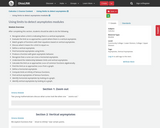
- Subject:
- Calculus
- Mathematics
- Material Type:
- Unit of Study
- Provider:
- Ohio Open Ed Collaborative


After completing this section, students should be able to do the following.State the definition of a function.Find the domain and range of a function.Distinguish between functions by considering their domains.Determine where a function is positive or negative.Plot basic functions.Perform basic operations and compositions on functions.Work with piecewise defined functions.Determine if a function is one-to-one.Recognize different representations of the same function.Define and work with inverse functions.Plot inverses of basic functions.Find inverse functions (algebraically and graphically).Find the largest interval containing a given point where the function is invertible.Determine the intervals on which a function has an inverse.


After completing this section, students should be able to do the following.Recognize when a limit is indicating there is a vertical asymptote.Evaluate the limit as xx approaches a point where there is a vertical asymptote.Match graphs of functions with their equations based on vertical asymptotes.Discuss what it means for a limit to equal ∞∞.Define a vertical asymptote.Find horizontal asymptotes using limits.Produce a function with given asymptotic behavior.Recognize that a curve can cross a horizontal asymptote.Understand the relationship between limits and vertical asymptotes.Calculate the limit as xx approaches ±∞±∞ of common functions algebraically.Find the limit as xx approaches ±∞±∞ from a graph.Define a horizontal asymptote.Compute limits at infinity of famous functions.Find vertical asymptotes of famous functions.Identify horizontal asymptotes by looking at a graph.Identify vertical asymptotes by looking at a graph.


After completing this section, students should be able to do the following.Determine when a function is a composition of two or more functions.Calculate indefinite and definite integrals requiring complicated substitutions.Recognize common patterns in substitutions.Evaluate indefinite and definite integrals through a change of variables.

The Calculus II course was developed through the Ohio Department of Higher Education OER Innovation Grant. This work was completed and the course was posted in February 2019. The course is part of the Ohio Transfer Module and is also named TMM006. For more information about credit transfer between Ohio colleges and universities, please visit: transfercredit.ohio.gov.Team LeadJim Fowler Ohio State UniversityRita Ralph Columbus State Community CollegeContent ContributorsNela Lakos Ohio State UniversityBart Snapp Ohio State UniversityJames Talamo Ohio State UniversityXiang Yan Edison State Community CollegeLibrarianDaniel Dotson Ohio State University Review TeamThomas Needham Ohio State UniversityCarl Stitz Lakeland Community CollegeSara Rollo North Central State College


After completing this section, students should be able to do the following.Determine if a series converges absolutely or conditionally.Answer conceptual questions about absolute convergence


After completing this section, students should be able to do the following.Apply the procedure of “Slice, Approximate, Integrate” to derive a formula for volume of solids with known cross-section areasSet up an integral or sum of integrals that gives the volume of a solid whose cross sections are familiar geometric shapes.


After completing this section, students should be able to do the following.Determine if a series converges using the alternating series test.Determine if a series converges absolutely.Determine if a series converges conditionally.Determine if an alternating series diverges.


After completing this section, students should be able to do the following.Understand linear density and its connection to mass.Calculate the mass of an objection with varying density.Understand work and how it is computed.Calculate work when force is varying.Know when to integrate a cross-section to solve a physics problem.Calculate work when distance is varying.


After completing this section, students should be able to do the following.Compute Taylor polynomials.Use Taylor’s theorem to estimate the error of a Taylor polynomial.Determine the maximum error between a function and a given Taylor polynomial.


After completing this section, students should be able to do the following.Apply the procedure of “Slice, Approximate, Integrate” to derive a formula for the area bounded by given curves.Understand the difference between net and total area.Find the area bounded by several curves.Set up an integral or sum of integrals with respect to xx that gives the area bounded by several curves.Set up an integral or sum of integrals with respect to yy that gives the area bounded by several curves.Decide whether to integrate with respect to xx or yy.
